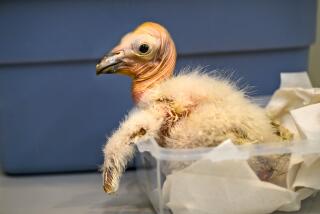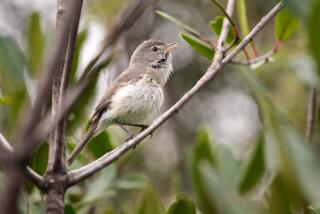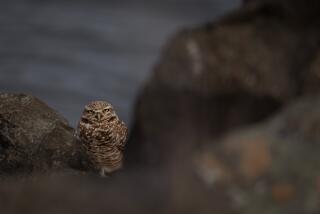Success Story, So Far : Whoopers: Life on Edge of Extinction
- Share via
BLACKJACK PENINSULA, Tex. — The great birds, treasures of the marshes, unfurled their snowy wings and began beating the air beneath them in unison.
Like overloaded cargo planes, the family of three whooping cranes at first lumbered along only a few feet from the ground, toiling to gain altitude. But within seconds they began to soar majestically, transforming themselves into sleek flying machines. Their stilt-like legs swung up behind them. They straightened their necks, longer and more agile than those of swans, to pare resistance to the gusting Texas wind.
Brace for Perilous Journey
The cranes flew effortlessly over the wetlands below, moving to another section of their watery domain. Then, with a feathery delicacy, they dropped back to earth and picked up where they had left off. They tucked in their wings, hiding the jet black tips beneath the dazzlingly white plumage, and began eating blue crabs and clams, fortifying themselves for the often perilous journey ahead, one that would soon take them from the Texas Gulf Coast to their summer nesting grounds 500 miles south of the Arctic Circle.
“They do that a lot this time of year,” said Capt. Ted Appell to the 33 bird fanciers on board his boat, the Skimmer. “They’re getting ready for the trip north, getting their muscles stronger. It’s a long trip.”
A few minutes later, a woman with a decidedly British accent approached Capt. Ted, as he calls himself, with a question: “Excuse me, but could you tell me, when they are supposed to whoop?”
“Whenever they decide it’s time to whoop,” the captain replied, the answer of a man who had been asked the question many times over his 14 years of guiding tourists through the 54,000-acre Aransas National Wildlife Refuge.
Tells of Miracle
Appell negotiated his shallow-draft craft through the waterways, pointing out more whoopers as he went along, occasionally cutting the engines so the birders could move to the upper deck with their cameras and binoculars. He talked enthusiastically about the miracle of the whooping crane, telling how North America’s largest bird was saved from extinction, how 109 whoopers were now at the refuge when once only 15 lived in the wild.
But then a barge moved down the Intracoastal Waterway, only 100 yards from the feeding birds, and the sight of it made Capt. Ted fume. A sign on the barge warned that it was carrying toxic materials. That one scene told the story of the whoopers. They had come back from the edge of extinction after 40 years of effort. But one accident, one major spill, could wipe out the entire population that winters here each year.
Nevertheless, the saga of the whooping crane is essentially a success story. At the latest count, there were 170 birds, including a new migratory flock being developed in a joint U.S.-Canadian program, as well as those in captivity. A government-sponsored recovery plan describes the whooping crane as a “symbol of international efforts now under way to save endangered wildlife throughout the world.”
Whoopers have survived hunters, egg collectors, poachers, foul weather, power lines, the plowing under of habitat, a U.S. Air Force bombing range near their refuge nearby and the dredging of the Intracoastal Waterway by the U.S. Army Corps of Engineers. Other species--like the California condor, with only one bird now left in the wild--have been more endangered. But for a number of reasons, the plight of the whooping crane permeated the national conscience long before there was an endangered species act.
Among the reasons are the crane’s beauty and aloofness, its strength and its ability to survive when most believed it would go the way of the now-extinct passenger pigeon and the Plains wolf.
‘No Credit to Us’
Robert Porter Allen, whose research into the whooping crane in the 1940s helped save it, once wrote: “If we succeed in preserving the wild remnant that still survives, it will be no credit to us; the glory will rest on this bird whose stubborn vigor has kept it alive in the face of increasing and seemingly hopeless odds.”
For years, imaginations were excited by the mystery about how these giant birds--5 feet tall, with wingspans of 7 1/2 feet--vanished when they left Texas in the spring and headed north. The answer to that riddle was found by accident 33 years ago when a Canadian forestry worker, returning by helicopter from a forest fire, spotted them nesting in a remote wilderness area just north of the province of Alberta.
The whooping crane is not the only kind of crane in North America. Its cousin, the smaller and more numerous sandhill crane--is now playing a major, though uncertain, role in efforts to save the whooper, and 12 other species in varied parts of the world.
For centuries, the crane has held a distinct and honored place. Homer told of cranes. Frederick II of Germany considered the crane one of the most worthy victims for his falcons. Just as in ancient Japan, only the emperor’s falcons could be used to hunt the crane. Chaucer wrote “the crane the giant, with his trompes sound.”
First Spotted in 1589
The first recorded sighting of whooping cranes was by explorer Philip Amadas in 1589 on Wokokon Island off the coast of North Carolina. Amadas wrote that after his men went ashore, they fired their guns and “such a flocke of Cranes (the most part white) arose, with such a crye, redoubled by many ecchoes, as if an armie of men had showted together.”
More recently, author Tom Robbins, in his best-selling book “Even Cowgirls Get the Blues,” wrote in awe of the whoopers: “Imagine Wilt Chamberlain in a red yarmulke and snowy feathers . . . “ and “I give up. The whooper enters one’s spirit the instant it enters one’s senses. It is a perfect radiant sky monster and I cannot describe it.”
The whooper has been around for several million years. It thrived when the North American continent was a vast grassy plain, ranging from near the Arctic Circle to the interior of Mexico. But the geography of the earth changed. Mountains and forests came on the scene, and the whooper refused to adapt.
Centuries later, civilization arrived and took further toll on the dwindling species. Farmers plowed fields and drained wetlands that had been the birds’ habitat. Hunters shot them for food.
The whooper was dying out when, in 1937, the Aransas refuge, once the haunt of the pirate Jean Lafitte, was formally designated a wildlife sanctuary by the U.S. government. At the time, there were only 29 whooping cranes left, 18 of them at Aransas and 11 in the Louisiana wetlands. The Louisiana whoopers, for whatever reasons of nature, had chosen to become non-migratory.
Low Point in 1941
The low point in the count came in 1941, when only 15 returned to the Texas coast, setting off a national cry to save the birds.
David Blankinship, a biologist with the National Audubon Society, has spent 16 years on the coast watching over the whooping cranes. A soft-spoken man, he still remembers talking to people whose fathers or grandfathers thought nothing of shooting the birds. Now, whoopers are part of the lifeblood of Rockport, the largest town adjacent to the wildlife refuge.
“There’s a very strong economic impact for this area,” Blankinship said as he sat in a Rockport, Tex., restaurant. “It’s several million dollars a year that the cranes bring into this area.”
The conservationist in him likes that, because when birds pump fresh money into a limited economy, that ensures that they have the loyalty of local citizens. He also is encouraged by this year’s fresh crop of 21 chicks, the largest recorded number ever to make the 2,400-mile flight to the wildlife refuge from the nesting grounds in Wood Buffalo National Park, Northwest Territories.
But like Appell, the tour boat captain, Blankinship still has those constant worries about the tenuous existence of the cranes. He even worries about the likes of Appell, fearing the birds will someday be too exposed to man.
Sees Peril in Numbers
“It’s the sheer numbers,” he said. “You’ve got the tour boats, private boats, the commercial traffic on the waterway.”
Then, there is the dumping of trash, both by ships offshore and beachgoers in such quantities that it is evolving into an environmental crisis along the Texas coast. Gas and oil wells are close by, as are underwater pipelines. The shoreline is eroded by the wakes thrown up by barges. Blankinship worries about more dredging of the waterway and what will be done with the refuse, as well as about the commercial uses of the rivers upstream that could contaminate the water. And there is always the possibility of a disease outbreak, like the one in 1984 in which seven captive cranes died of eastern equine encephalitis.
U.S. Fish and Wildlife biologist Tom Stehn, the whooping crane specialist at the wildlife refuge, says he won’t rest easy until there are at least 200 cranes in the Aransas wetlands, and only then if there are at least two other flocks in the wild.
There is one other flock already, which winters in New Mexico and summers in Idaho, nurtured along by biologists taking whooping crane eggs and placing them in the nests of sandhill cranes. That program, begun in 1975, has produced a flock of 22 whoopers, but has been a disappointment because thus far the whoopers have not mated. The program may be discontinued if there is no progress over the next two years. There is also a proposal to develop a non-migratory flock in either Georgia or Florida.
20 Years on Job
While the egg transfers have not yet been successful, that does not diminish the work of Ernie Kuyt of the Canadian Wildlife Service, who for 20 years has been the keeper of the whoopers in their boggy summer nesting grounds.
He has removed all but five of the hundreds of whooper eggs used to raise both the New Mexico-Idaho migratory flock and the captive population of 38 whoopers in Patuxent Wildlife Research Center in Laurel, Md.
Whooping cranes normally lay eggs in pairs, but can rarely care for both chicks. To do his job, Kuyt said, he must take a helicopter in to retrieve the eggs, always taking one and leaving another behind, and then race against the clock, on commercial and charter flights and then by air-boat, to get the eggs from Canada to the nests of the sandhill cranes in Idaho before they hatch.
He also returns to the Canadian nesting grounds later in the summer to band the chicks so biologists in the Aransas refuge will know exactly which birds survived the migration south.
“It’s a relatively simple process,” Kuyt, who is given to understatement, said of his work, which includes slogging through marshes and catching the chicks by hand.
Never-Ending Worry
Within the next few days, the flock of majestic birds here on the Texas coast will again set out on the journey to Canada, where Kuyt’s work will begin again. Then, back at their Aransas refuge, the government and Audubon biologists will fret next fall until all the whoopers are counted.
Jesse Grantham, another Audubon biologist stationed in Rockport, was telling about a man he met the other day--an avid duck hunter who had no use for the whooper. He said too much money was spent to preserve the bird, that it was at the end of its life on earth and that the best thing was just to let that happen.
“What do you say to someone like that?” asked Grantham, who before coming to Texas four months ago worked to save the California condor. “How could anyone say that it’s time for an animal to go out of existence?”
More to Read
Sign up for The Wild
We’ll help you find the best places to hike, bike and run, as well as the perfect silent spots for meditation and yoga.
You may occasionally receive promotional content from the Los Angeles Times.






